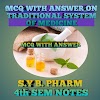Pharmacognosy & Phytochemistry - II
Unit II
GENERAL INTRODUCTION, COMPOSITION, CHEMISTRY AND CHEMICAL CLASS, BIOSOURCES, THERAPEUTIC USES AND COMMERCIAL APPLICATION OF VARIOUS SECONDARY METABOLITES
Points to be covered.
ALKALOIDS
Definition:
The
term ‘alkaloid’, means alkali-like, is a group of naturally occurring chemical|
compounds that contain one or more basic nitrogen atoms in heterocyclic ring.
These compounds having marked physiological action on human and animal when
taken at low dose, otherwise become toxic or poisonous at high concentration.
Classification of
Alkaloids:
1. True or typical alkaloids
are derived from amino acids and have nitrogen atom in heterocyclic ring. E.g.
Atropine.
2. Proto alkaloids
are derived from amino acids and do not contain nitrogen atom in heterocyclic
ring. E.g. Ephedrine.
3. Pseudo alkaloids
are not derived from amino acids, but contain nitrogen atom in heterocyclic
ring. E.g. Caffeine.
4. False alkaloids
are non-alkaloids which give false positive reaction with alkaloidal reagents.
- True
alkaloids: These are subdivided into 12
groups:
- Pyrrole and pyrrolidine:
Hygrine, coca species.
- Pyridine and piperidine:
Arecoline, Anabasine, trigonelline.
- Pyrrolizidine: Echimidine,
symphitine. Cho
- Tropane: Atropine, hyoscine.
- Quinoline: Quinine, Quinidine,
Chinchonine.
- Isoquinoline: Morphine,
codeine.
- Aporphine: Boldine.
- Indole (Benzpyrole):
Vincristin, Ergometrine, Reserpine.
- Imidazole: Pilocarpine, Isopilocarpine.
- Norlupinane: Cytisine,
Sparteine.
- Purine (pyrimidine/imidazole):
Caffine, theobromine, theophylline.
- Steroidal (cyclopentano
perhydrophenathrene ring): Solanidine, Conessine.
- Pseudo alkaloids: @ Diterpenes: Aconitine, Aconine.
- Proto alkaloids: Alkyl amines or amino alkaloids: Ephedrine, Colchinine.
Physico-chemical
Properties of Alkaloids:
- Alkaloids have molecular
weight from 100 - 900.
- Although most of the bases
that do not contain oxygen atom are liquids at ordinary temperature (nicotine,
coniine), those that contain oxygen atom are normally crystallizable
solids and in rare cases they are coloured (berberine).
- Almost all of the crystallized
bases rotate the plane of polarized light and have melting points without
decomposition especially below 200°C.
- As a general rule, alkaloids
as bases are not soluble in water, but are soluble in a polar or only slightly
polar organic solvents.
- The basicity of alkaloids
varies greatly since this property depends entirely on the availability of
the lone pair of electrons on the nitrogen atom.
- Electron withdrawing group in
proximity to the nitrogen atom decreases the basicity whereas electron
donating group enhances it.
- The basic character allows the
formation of salts with mineral acids (hydrochloridg sulphates, nitrates)
and organic acids (tartarate, sulphonate).
- Alkaloid salts are generally
soluble in water and in dilute alcohols and they are except in rare case,
not soluble in organic solvents.
- Pseudoalkaloids and
protoalkaloids show higher solubility in water, while free base, of
alkaloids are soluble in organic non-polar immiscible solvents.
Tests for
Identification of Alkaloids:
The
different reagents used for the identification are:
·
Mayer's
reagent (Potassium mercuric iodide solution) 1 ml of test
solution + a drop or two of the Mayer’s reagent white or a creamy precipitate.
·
Dragendorff's
reagent (Potassium bismuth iodide solution) 2 ml of the
filtrate+1 ml of Dragendorff’s reagent. Formation of orange or reddish
brown precipitate.
·
Wagner's
reagent (lodine potassium Iodide solution) 2 drops of
Wagner’s reagent was added to 1ml of the test solution. The formation of yellow
or brown precipitate confirmed the test as positive for alkaloids.
·
Hager's
reagent (picric acid solution) 1 ml of test solution + a
drop or two of Hager’s reagent formation of yellow precipitate.


















0 Comments
Please do not enter any spam link in the comment box.